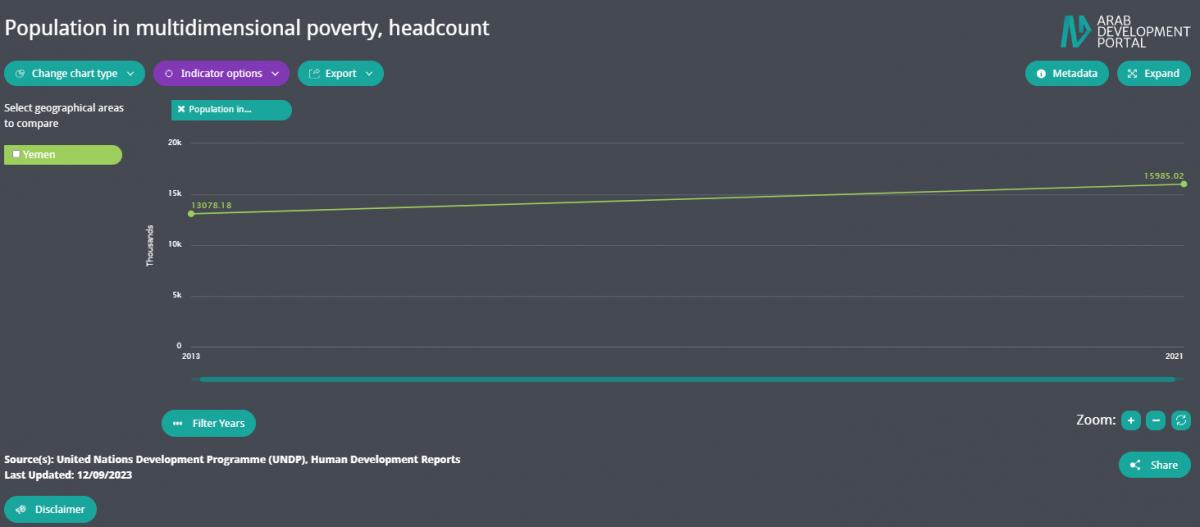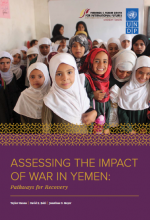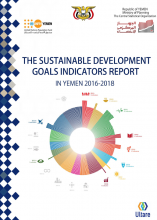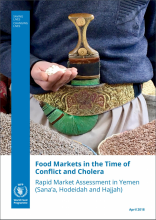 Yemen
Yemen
Yemen is home to an estimated population of 33.3 million in 2022[1], the majority of which is rural, with only 39.2 percent of the population living in urban areas.[2] Almost 60 percent of the total population is below the age of 24, down from 70 percent in 2000.[1]
Yemen’s Human Development Index (HDI) value for 2021 is 0.455 down from 0.51 in 2010– which put the country at the lower range of the low human development category – positioning it at 183rd out of 191 countries and territories. When adjusted for inequality, the country loses 32.5 percent of its already low HDI value, largely due to inequality in education.[3]
The ongoing crisis in Yemen has been classified by UNOCHA as the worst humanitarian crisis in the world for the past four years and has already delayed human development in Yemen by 21 years. A persistent conflict would certainly delay development by additional years.[4]
The fighting raging since early 2015 has devastated its economy, leading to severe food insecurity, and destroying critical infrastructure. The UN estimated that 24.1 million people in 2023 were at risk of hunger and disease, and roughly 14 million were in acute need of assistance,[7] There are now over 4.5 million people who fled their homes and remain internally displaced in 2022.[6]
Around 18 million Yemenis do not have access to safe water and sanitation and a staggering 16.2 million people require urgent emergency assistance because of food insecurity and even malnutrition.[7] Consequently, and over six years of escalating violent conflict and economic collapse, Yemen has been wrestling with mass outbreaks of preventable diseases, such as cholera leading to a dramatic deterioration of the humanitarian conditions in the country. Yemen suffers from the worst cholera outbreak recorded in history, where cholera remained widespread in 90 percent of the districts in 2019.[8]
In 2015, The GDP growth witnessed a sharp decline of -28 percent.[9] In 2018, growth rates became positive for the first time reaching 0.75 percent and 2.1 percent in 2019. However, growth contracted by -8.5 percent and -1 in 2020 and 2021 and recovered to 1.5 percent in 2022.[9] Oil and gas production fell by 90 percent since 2014. Agricultural production was also considerably hit by conflict, water scarcity, and fuel shortages. In 2016, the size of cultivated areas in Yemen declined by an average of 38 percent.[8]
Unprecedented currency depreciations in 2018 and 2019 led to lasting inflationary pressure on the Yemeni riyal, undermining Yemenis’ purchasing power and further aggravating the humanitarian crisis. Inflation declined since the 46.7 percent peak in 2017, reaching 1.3 percent by the end of 2019 but then peaked again to 50.4 percent in 2021. In 2014, before the conflict, inflation in Yemen was 10 percent.[9] In 2019, average food prices were almost 150 percent higher than the pre-conflict levels, while fuel prices in 2018 were three times higher than the pre-conflict levels.[10] Furthermore, according to The World Bank’s latest statistics, more than 40 percent of households in Yemen have lost their primary source of income and consequently their ability to purchase their basic necessities. Poverty worsened even before the crisis, affecting almost half of Yemen’s population.[7]
With an overall labour force participation rate of 38.3 percent, the participation rate for men is significantly higher than that for women, 70.3 percent, and 6.2 percent respectively in 2022. Yemen’s unemployment rate has fluctuated around 13 percent since 2010 and is much higher for women reaching 26.3 percent in 2022 compared to 12.47 percent for men.[11]
Before the 2015 conflict, Yemen was making substantial progress in education. Primary gross enrolment increased from 72.4 percent in 1999 to 93.6 percent in 2016, while girls’ enrolment grew from 51.6 percent to 87.1 percent during the same period.[5] However, the conflict caused a deterioration in the education sector. Over two million children are out-of-school in addition to over four million who need support to access education, and over 20 percent of all primary and secondary schools are closed.[10]
This overview was last updated in November 2023. Priority is given to the latest available official data published by national statistical offices and/or public institutions.
Sources:
[1] Population Division of the Department of Economic and Social Affairs of the United Nations Secretariat. 2023. World Population Prospects. [ONLINE] Available at: https://population.un.org/wpp/ [Accessed 23 October 2023].
[2] Population Division of the Department of Economic and Social Affairs of the United Nations Secretariat. 2023. World Urbanization Prospects. [ONLINE] Available at: https://population.un.org/wup/ [Accessed 23 October 2023].
[3] United Nations Development Programme (UNDP). 2023. Human Development Index. [ONLINE] Available at: https://hdr.undp.org/data-center/documentation-and-downloads [Accessed 25 October 2023].
[4] United Nations Development Programme (UNDP). 2019. Assessing the impact of war on development in Yemen. [ONLINE] Available at: https://yemen.un.org/sites/default/files/2019-09/Assessing%20the%20Impact%20of%20War%20on%20Development%20in%20Yemen.pdf [Accessed 27 July 2021].
[5] The World Bank. 2023. World Development Indicators. [ONLINE] Available at: https://databank.worldbank.org/data/source/world-development-indicators [Accessed 23 August 2023].
[6] United Nations High Commissioner for Refugees (UNHCR). 2023. Refugee Population Statistics Database. [ONLINE] Available at: https://www.unhcr.org/refugee-statistics/download/ [Accessed 15 October 2023].
[7] The World Bank. 2023. Yemen Overview. [ONLINE] Available at: https://www.worldbank.org/en/country/yemen/overview [Accessed 26 November 2023].
[8] United Nations Development Programme. 2019. Assessing the Impact of War on Development in Yemen. [ONLINE] Available at:
https://www.undp.org/content/dam/yemen/General/Docs/ImpactOfWarOnDevelopmentInYemen.pdf [Accessed 25 November 2020].
[9] International Monetary Fund. 2023. World Economic Outlook. [ONLINE] Available at: https://www.imf.org/en/Publications/SPROLLs/world-economic-outlook-databases#sort=%40imfdate%20descending [Accessed 24 October 2023].
[10] United Nations Office for the Coordination of Humanitarian Affairs. 2023. Yemen: Conflict leaves millions of children without proper education. [ONLINE] Available at: https://reliefweb.int/report/yemen/yemen-conflict-leaves-millions-children-without-proper-education-enar [Accessed 26 November 2023].
[11] International Labor Organization. 2023. ILO stat [ONLINE] Available at: https://ilostat.ilo.org/ [Accessed 23 September 2023].
Data Highlights
-
In 2013, 13 million people were multi-dimensionally poor, with an additional 2.9 million who joined them in 2021, almost half of the population became multi-dimensionally poor




